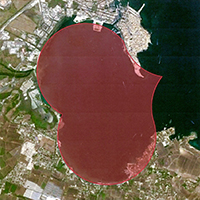Policies of Resilience in the New Institutional Process. The Case-Studies of Palermo and Siracusa in the South of Italy.
Abstract
At the end of 2012, the PON METRO National Scheme was set up in Italy, inspired by the EU Urban Agenda. It also allows towns like Palermo to test and reach targets of urban resilience, focusing on mobility and sustainable energy in order to improve life in the cities together with innovative policies of social inclusion. Other medium-sized cities also tried to face the problem of urban resilience without using national funds. The city of Siracusa, for example, made use of EU direct co-financing schemes. This paper aims to analyse the planning projects and measures adopted in Sicily over the past few years in order to examine government approaches focusing on resilience or those that are somehow linked to it. The comparison shows that, despite the wide range of opportunities (European, National and Regional policies, etc.) a number of differences may be listed in the adoption of schemes for urban planning and for the implementation of transition measures from a linear, rational, sequential, normative and regulative approach to the circular, active, flexible and versatile approach needed to tackle the problems linked to urban resilience. This proposal suggests that new policies are needed. The new policies should focus not only on funds but also on the creation of an innovative laboratory of projects involving all the cities in equal ways and on the building of a platform to exchange data and compare the different practices adopted in relation to urban and local resilience.Downloads
References
Allen, C.R., Angeler, D.G., Garmestani, A.S., Gunderson, L.H. & Holling, C.S., (2014). Panarchy: Theory and Application (Nebraska Cooperative Fish & Wildlife Research Unit - Staff Publications. Paper 127). Ecosystems (2014). doi: 10.1007/s10021-013-9744-2
Aureli, A., Carrubba, S. Cusimano, G., Dipasquale, M., Mazzucco, N., Privitera, A.M.G., Silluzio, C., Tosto, S. & Zingale, V. (2004). Vulnerability maps pollution to hydrocarbon and urban pollution in seawater intrusion area. Geofisica Internacional, 43 (4), 683-688. Retrieved October 8, 2015, from
Carmin, J., Dodman, D., & Chu, E. (2013). Urban Climate Adaptation and Leadership: From Conceptual Understanding to Practical Action (OECD Regional Development Working Papers, 2013/26), OECD Publishing. Retrieved September 20, 2015, from http://dx.doi.org/10.1787/5k3ttg88w8hh-en
Cavaleri, L., Fimiani, D., Giambalvo, M., Lucido, S., Mannoia, M., Mattina, G., Picone, M., & Rinaldi, C. (2008). Le città nella città. Politiche urbane, disagio e devianza minorile alla periferia di Palermo. NExT – Nuove Energie per il Territorio Research Report. Palermo, Italy. Retrieved September 20, 2015, from http://www.nuovenergie.org/materiali/Le%20citta%20nella%20citta.pdf
Colucci, A. (2012). Towards resilient cities. Comparing approaches/strategies. TeMA. Journal of Land Use, Mobility and Environment, 5(2), 101-116, doi: 10.6092/1970-9870/921.
Davoudi, S. (2012). Resilience: A bridging concept or a dead end? Planning Theory and Practice, 13 (2), 299-307. doi: 10.1080/14649357.2012.677124.
Davoudi, S. (2013). On resilience. disP: The Planning Review, 49(1), 4-5. doi: 10.1080/02513625.2013.799852.
Davoudi, S., Brooks, E. & Mehmood, A. (2013). Evolutionary resilience and strategies for climate adaptation. Planning Practice and Research, 28(3), 307-322. doi: 10.1080/02697459.2013.787695
European Commission (2011). Communication from the Commission to the European Parliament, the Council, the European Economic and Social Committee and the Committee of the Regions A Budget for Europe 2020. Part II: Policy fiches. Brussels: Belgium. Retrieved October 9, 2015, from
http://ec.europa.eu/budget/library/biblio/documents/fin_fwk1420/MFF_COM-2011-500_Part_II_en.pdf
Folke, C., Carpenter, S.R., Walker, B., Scheffer, M., Chapin T. & Rockstrom, J. (2010). Resilience thinking: integrating resilience, adaptability and transformability. Ecology and Society, 15(4), 20. Retrieved October 8, 2015, from http://www.fs.fed.us/pnw/pubs/journals/pnw_2010_folke.pdf
Galderisi, A., Ferrara, FF. (2012). Enhancing urban resilience in face of climate change: a methodological approach. TeMA Journal of Land Use, Mobility and Environment, 5(2), 69-87, doi: 10.6092/1970-9870/936.
Gunderson, L.H., Holling, C.S. (Eds.). (2002). Panarchy: understanding transformations in human and natural systems. Washington DC: Island Press.
Harrison, P., Bobbins, K., Culwick, C., Humby, T.L., La Mantia, C., Todes, A. & Weakley D. (2014). Urban Resilience. Thinking for Municipalities. University of the Witwatersrand, Gauteng City-Region Observatory, South Africa. Retrieved October 8, 2015, from http://mobile.wiredspace.wits.ac.za/bitstream/handle/10539/16490/URreport_1901MR.pdf?sequence=3&isAllowed=y
Holling, C.S. (1973). Resilience and Stability of Ecological Systems. Annual Review of Ecology and Systematics, 4, 1-23. doi: 10.1146/annurev.es.04.110173.000245
Holling, C.S. (2001). Understanding the complexity of Economic, Ecological, and Social Systems. Ecosystems, 4, 390-405. doi: 10.1007/s10021-00 -0101-5
Porter, L. & Davoudi, S. (2012). The politics of resilience for planning: A cautionary note. Planning Theory and Practice, 13(2), 329-333. doi: 10.1080/14649357.2012.677124
Salat, S., Bourdic, L. (2012). Systemic resilience of complex urban systems, TeMA. Journal of Land Use, Mobility and Environment, 5(2), 55-68, doi: 10.6092/1970-9870/918.
Starik, M. & Kanashiro, P. (2013). Toward a Theory of Sustainability Management: Uncovering and Integrating the Nearly Obvious. Organization & Environment, 26(1), 7-30. doi: 10.1177/1086026612474958
Walker, B. & Salt, D. (2006). Resilience thinking: sustaining ecosystems and people in a changing world, Washington DC: Island Press.
Walker, B., Holling, C.S., Carpenter, S.R. & Kinzig, A. (2004). Resilience, adaptability and transformability in social–ecological systems. Ecology and Society, 9(2), 5. Retrieved October 8, 2015, from http://www.ecologyandsociety.org/vol9/iss2/art5/

Copyright (c) 2015 Tema. Journal of Land Use, Mobility and Environment

This work is licensed under a Creative Commons Attribution 4.0 International License.
Authors who publish in this journal agree to the following:
1. Authors retain the rights to their work and give in to the journal the right of first publication of the work simultaneously licensed under a Creative Commons License - Attribution that allows others to share the work indicating the authorship and the initial publication in this journal.
2. Authors can adhere to other agreements of non-exclusive license for the distribution of the published version of the work (ex. To deposit it in an institutional repository or to publish it in a monography), provided to indicate that the document was first published in this journal.
3. Authors can distribute their work online (ex. In institutional repositories or in their website) prior to and during the submission process, as it can lead to productive exchanges and it can increase the quotations of the published work (See The Effect of Open Access)
